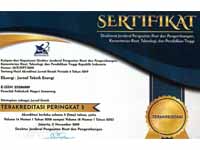Dual Axis Solar Tracker System Application Based on Arduino Atmega 2560 and Internet of Things (iot) for Submersible Pump Operation
DOI:
https://doi.org/10.32497/eksergi.v18i3.3910Keywords:
solar panels, solar tracker, research and development (R&D), submersible pump, dual axis solar tracker efficiencyAbstract
Most of the Solar Power Plants (PLTS) still use a static system which is considered less effective in absorbing solar energy. This is due to the earth's rotation which causes the sun to not always be in the same position. In order to optimize the absorption of solar energy so that the power produced is stable and maximum, a tracking system is applied to the solar panels. This tool works by using 4 LDR sensors and 2 DC Power Window motors as the driving force and the presence of Wi-Fi as a communication medium between the Arduino ATmega 2560 and the Android application so that the performance of the solar tracker can be monitored via a smartphone in real time. The purpose of this research is to optimize the efficiency of solar panels. The method used in this research is Research and Development (R&D). The test was carried out with the Dual Axis Solar Tracker system against a load in the form of a submersible pump. The test results show the average efficiency of the Dual Axis Solar Tracker system is 20.89% with an average power output of 84.81%.
References
Aquino Larico, E. R., & Gutierrez, A. C. (2022). Solar Tracking System with Photovoltaic Cells: Experimental Analysis at High Altitudes International Journal of Renewable Energy Development, 11(3), 630”“639 https://doi.org/10.14710/ijred.2022. 43572
Arman, M., 2017. Rancang Bangun Solar Tracker Berbasis Mikrokontroler Arduino Mega 2560 Dalam Sistem Photovoltaic. Skripsi. Fakultas Pendidikan Teknologi dan Kejuruan Universitas Pendidikan Indonesia, Bandung.
BRAC University, IEEE Power & Energy Society, & Institute of Electrical and Electronics Engineers. (n.d.). International Conference on Energy and Power Engineering : 2019 ICEPE : Theme: Power for Progress : 14-16 March, 2019, BCOM, Savar, Dhaka, Bangladesh, Department of Electrical & Electronic Engineering, Brac University..
Eko Nugroho, B., Eko Prasetiyo, E., Marausna, G., & Tinggi Teknologi Kedirgantaraan Yogyakarta, S. (2022). Rancang Bangun Dual Axis Sun Tracker Menggunakan Motor DC Power Window CSD60-B (Vol. 10, Issue 1).
el Hammoumi, A., Motahhir, S., el Ghzizal, A., & Derouich, A. (2021). Internet of Things-Based Solar Tracker System. In Green Energy and Technology (pp. 75”“95). Springer Science and Business Media Deutschland GmbH. https://doi.org/10.1007/978-3-030- 64565-6_4
Fardani, M.I.M., 2018. Perancangan Prototipe 2 Axis Solar Tracker Guna Optimalisasi Output Daya Solar Panel.
Fauzi, K. W., Arfianto, T., & Taryana, N. (2018). Perancangan dan Realisasi Solar Tracking System Untuk Peningkatan Efisiensi Panel Surya Menggunakan Arduino Uno. TELKA - Telekomunikasi, Elektronika, Komputasi Dan Kontrol, 4(1), 63”“75. https://doi.org/10.15575/telka.v4i1. 68
Gbadamosi, S. L. (2021). Design and implementation of IoT-based dual- axis solar PV tracking system. https://doi.org/10.15199/48.2021.1 2.09
Jamroen, C., Komkum, P., Kohsri, S., Himananto, W., Panupintu, S. and Unkat, S., 2020. A low-cost dual- axis solar tracking system based on digital logic design: Design and implementation. Sustainable Energy Technologies and Assessments, 37, p.100618.
Khotama, R., Santoso, D. B., & Stefanie, A. (2020). Perancangan Sistem Optimasi Smart Solar Electrical pada Pembangkit Listrik Tenaga Surya (PLTS) dengan Metode Tracking Dual Axis Technology. Jurnal Ecotipe (Electronic, Control, Telecommunication, Information, and Power Engineering), 7(2), 78”“84. https://doi.org/10.33019/jurnalecoti pe.v7i2.1887
Majhool, M. H., Salim Alrikabi, H. T. H., & Farhan, M. S. (2021). Design and Implementation of Sunlight Tracking Based on the Internet of Things. IOP Conference Series: Earth and Environmental Science, 877(1).https://doi.org/10.1088/1755-1315/877/1/012026
Mustafa, F.I., Shakir, S., Mustafa, F.F. and Naiyf, A.T., 2018, March. Simple design and implementation of solar tracking system two axis with four sensors for Baghdad city. In 2018 9th International Renewable Energy Congress (IREC) (pp. 1-5). IEEE.
Putra, A. R., Kusumanto, R. D., & Taqwa, A. (2019). Minimum power of solar Panel Movement in Solar Tracker System Prototype. Journal of Physics: Conference Series, 1167(1). https://doi.org/10.1088/1742- 6596/1167/1/012030
Raharja, W.K., 2019. Optimalisasi Daya Sistem Sel Surya Menggunakan Solar Tracker Dual Axis. Jurnal Ilmiah KOMPUTASI, 18(1), pp.17- 32.
Rezkyanzah, J., Purba, L.P. and Putra, C.A., 2018. Perancangan solar tracker berbasis arduino sebagai penunjang sistem kerja solar cell dalam penyerapan energi matahari. SCAN Jurnal Teknologi Informasi dan Komunikasi, 11(2), pp.55-60.
Downloads
Published
Issue
Section
License
Authors who publish with this journal agree to the following terms:Authors retain copyright and grant the journal right of first publication with the work simultaneously licensed under a Creative Commons Attribution License that allows others to share the work with an acknowledgement of the work's authorship and initial publication in this journal.
Authors are able to enter into separate, additional contractual arrangements for the non-exclusive distribution of the journal's published version of the work (e.g., post it to an institutional repository or publish it in a book), with an acknowledgement of its initial publication in this journal.
Authors are permitted and encouraged to post their work online (e.g., in institutional repositories or on their website) prior to and during the submission process, as it can lead to productive exchanges, as well as earlier and greater citation of published work (See The Effect of Open Access).






